(This is an English translation of the original Japanese article.
The publication date refers to that of the Japanese version,
which differs from the upload date of the English version.)
When we think of gentians, we usually imagine blue-purple petals and single-layered flowers, often used as offerings on altars or graves. However, the Iwate Agricultural Research Center and the Hachimantai City Floricultural Research and Development Center have developed voluminous double-layered gentians, opening up new uses such as bridal bouquets, gifts for celebrations, and gardening. In the future, overseas production and export are being considered, and contributions to the flower industry in Iwate Prefecture are expected.
Double flower "Iwate Yae no Kagayaki Blue" debuts
In September of this year, a new gentian vairety that never happened before debuts in Iwate Prefecture. Its name is "Iwate Yae no Kagayaki (Double-Layered Shining) Blue" (Photo 1). Developed by a research group led by the Iwate Agricultural Research Center, it is a double-layered gentian variety with petals that shine blue and overlap as they bloom. The name was chosen from among about 100 public entries. A naming ceremony was held in Morioka City to celebrate its grand launch.
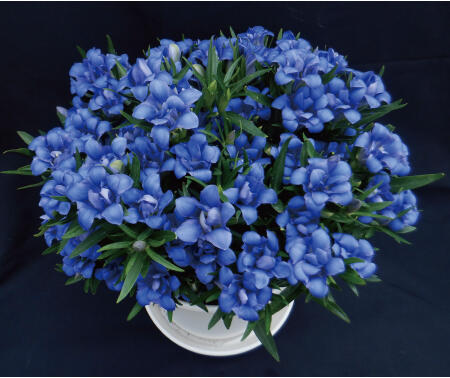
Photo 1: Iwate Yae no Kagayaki Blue double flower
(provided by the Iwate Agricultural Research Center)
Three types of "Ashiro Bouquet" are also born
Iwate Prefecture is the largest producer of gentians in Japan, accounting for about 60% of the country's shipments. To further expand the opportunities for gentians to be used, there was a strong desire to develop new and novel varieties. The Hachimantai City Floricultural Research and Development Center, located in the main production area of gentians, and its partners have been working on improving varieties with the aim of developing "double-layered" and "red-colored" gentians for the past six years. There have been double-layered gentians born from natural mutations in the past, but their shape and appearance were poor, with spots on their petals, making it difficult to use them as suitable varieties for the purpose.
Therefore, by repeatedly crossing with other gentian breeding lines, seven attractive double-layered varieties were finally created. From among these, gentian producers in the Ashiro area of Hachimantai City shipped three potted varieties (Photos 2-4) for the first time in the fall of 2021. These colorful double-layered gentians have a long-lasting bloom and are popular as gifts or for viewing, and are gaining popularity as "Ashiro Bouquets". "Iwate Yae no Kagayaki Blue" is also a gentian born from this research.
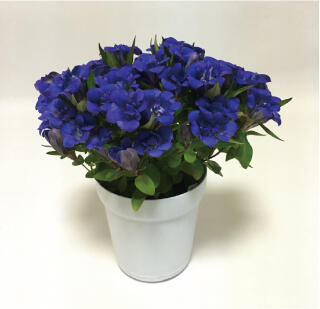
Photo 2: Ashiro Bouquet Marine
(provided by Hachimantai Floricultural Research and Development Center)
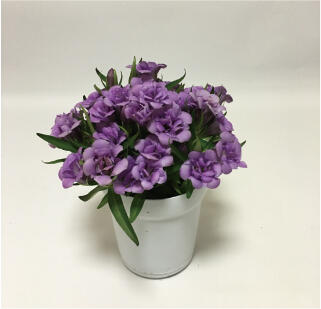
Photo 3: Ashiro Bouquet Rosé
(provided by Hachimantai Floricultural Research and Development Center)
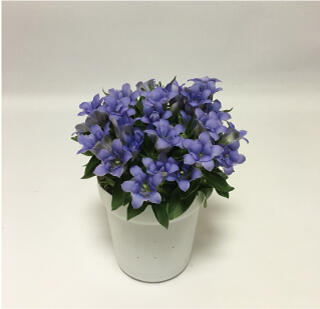
Photo 4: Ashiro Bouquet Aqua
(provided by Hachimantai Floricultural Research and Development Center)
Utilizing DNA markers and biotech breeding technology
One of the reasons why double-flowered gentians were efficiently bred is the use of DNA marker-assisted breeding technology. This method involves selecting the desired seedlings efficiently from a large number of seedlings bred through crossbreeding, using the genetic sequence related to double-flowering (identification DNA marker) as a guide (Photo 5). In addition, to speed up the process of variety improvement, techniques such as chromosome doubling using colchicine (a biologically active substance found in seeds such as autumn crocus and used for variety improvement of seedless watermelons, etc.) were also useful in breeding.

Photo 5: Efficient selection is possible by selecting genotype seedlings enclosed in red frame
(Provided by Iwate Biotechnology Research Center)
Vivid red gentians to be born in the future
Along with the development of double-flowered gentians, the creation of a red variety has also been pursued. The original color of gentians is blue-purple. Until now, there have been varieties of flowers in pink and whitish colors using natural mutations, but there were no red-flowered varieties in Japan. The group led by the Hachimantai City Floricultural Research and Development Center repeatedly crossbred red varieties imported from New Zealand with Japanese gentians to create a red line (Photo 6).
こIn the breeding of this red line, the Iwate Biotechnology Research Center and its partners were the first in the world to successfully identify the genes involved in producing a more vivid red color, and used breeding efficiency technology based on the identification marker developed based on it. This vivid red line of gentians is not yet ready for market, but development of the variety is ongoing.
Dr. Masahiro Nishihara, head of Department of Horticultural Sciences at the Iwate Biotechnology Research Center, who is in charge of overall research and development, says passionately, "Gentians still have great potential for development. In the future, we want to develop varieties with new traits to further expand demand."
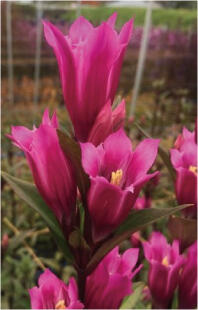
Photo 6: Red gentian under development
(provided by Hachimantai City Floricultural Research and Development Center)
Project name
Research Program on Development of Innovative Technology (Development Research Stage)
Project period
FY 2015 to 2019
Title
Development of Gentian Varieties for Demand Expansion Using Novel Breeding Techniques
Leading research institutes
Iwate Biotechnology Research Center (representative institution), Iwate University Faculty of Agriculture, Hachimantai City Floricultural Research and Development Center, Iwate Agricultural Research Center
